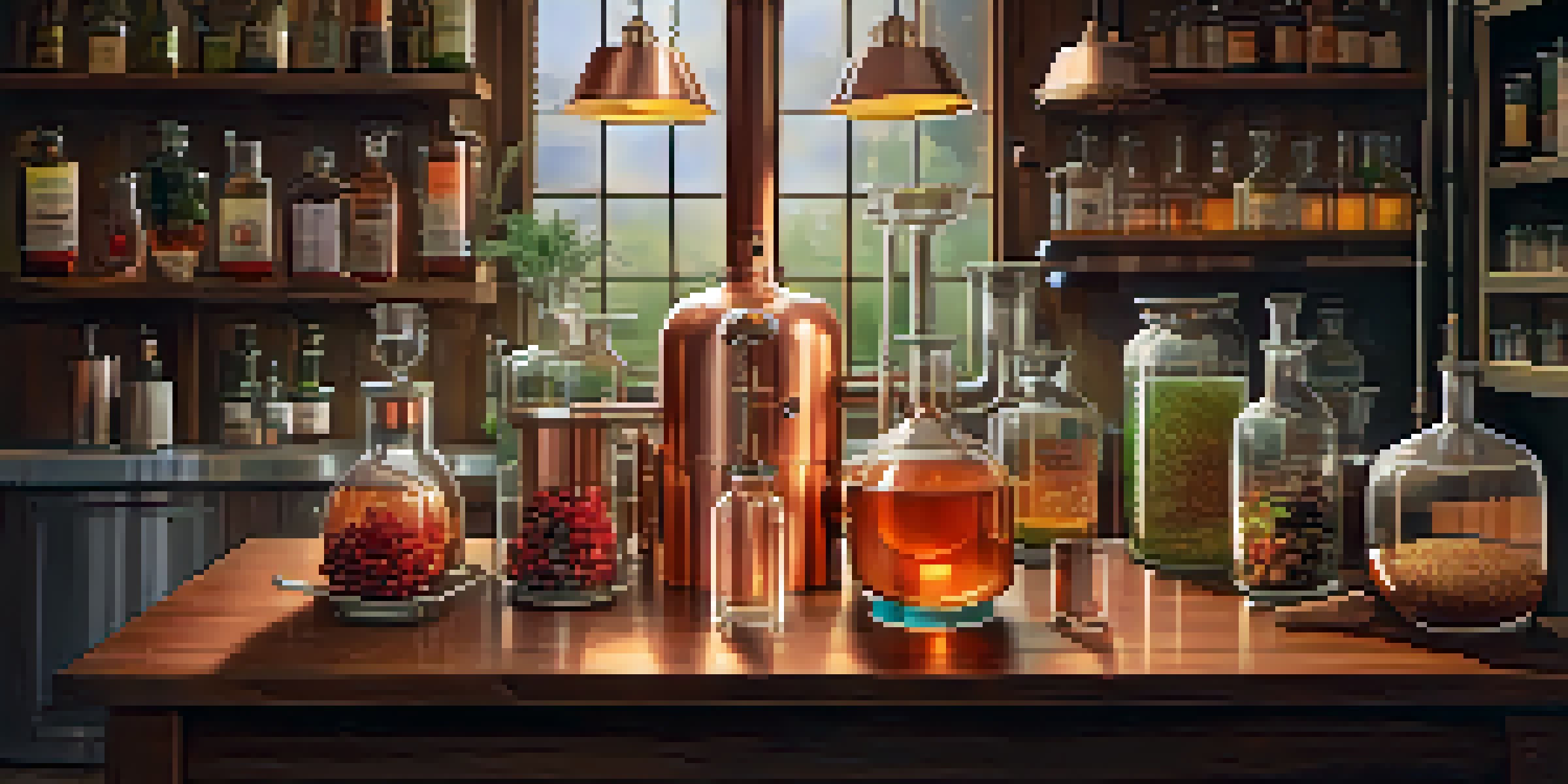How to Test Your Home Distilled Spirits for Quality

Understanding the Importance of Quality Testing
Testing the quality of your home distilled spirits is essential for ensuring a safe and enjoyable drinking experience. Just like a chef tastes their dish before serving, you want to make sure your spirits have the right flavor and potency. This process not only enhances your craft but also helps you identify any potential issues early on.
Good spirits should be enjoyed, not just consumed.
Quality testing can reveal a lot about your distillation process, including whether you’ve achieved the desired alcohol content and flavor profile. By paying attention to these factors, you can refine your techniques and improve future batches. Remember, quality spirits are a reflection of your skills and dedication.
Additionally, understanding how to test your spirits can help you avoid any harmful effects associated with poorly distilled alcohol. Safety should always come first, and knowing what to look for can prevent mishaps that could ruin your hard work.
Gathering the Right Tools for Testing
Before diving into the testing process, you’ll need some essential tools. A hydrometer, for example, is crucial for measuring the alcohol content of your spirits. A refractometer can also come in handy, particularly if you want to analyze the sugar content before fermentation.

In addition to these measuring tools, you'll want to have pH strips to assess the acidity of your spirits. This can influence flavor and stability. Lastly, a good tasting glass can enhance your sensory experience, allowing you to appreciate the aroma and appearance of your spirits.
Quality Testing Ensures Safety
Quality testing of home distilled spirits is crucial for ensuring safety and enhancing the overall drinking experience.
Having the right tools not only simplifies the testing process but also makes it more enjoyable. You’ll feel more confident in your results, and it can be a fun way to engage with your craft more deeply.
Testing Alcohol Content with a Hydrometer
One of the most straightforward tests you can perform is measuring the alcohol content with a hydrometer. This tool works by floating in your liquid; the level at which it floats indicates the specific gravity, which you can convert to alcohol by volume (ABV). Start by taking a reading of your wash before distillation and then again after distillation.
The only way to make great spirits is to continually improve your craft.
To use a hydrometer effectively, fill a test jar with your spirit and gently lower the hydrometer in. Make sure it’s not touching the sides, and take note of where the surface of the liquid meets the scale on the hydrometer. This will give you a clear picture of the potency of your spirit.
Regularly testing your alcohol content can help you maintain consistency across batches. It also allows you to adjust your process if you find that your spirits are consistently too strong or too weak.
Evaluating Flavor and Aroma with Tasting
Tasting your spirits is perhaps the most enjoyable part of quality testing. Start by observing the color and clarity of your liquid; a good spirit should be clear and visually appealing. Next, take a moment to smell the aroma. This can give you insight into the underlying flavors and overall quality.
When tasting, take a small sip and let it roll over your palate. Pay attention to the initial flavor, the mouthfeel, and the finish. Is it smooth, or does it have an unpleasant burn? This sensory evaluation is crucial for understanding how your distillation process affects the final product.
Essential Tools for Accurate Testing
Having the right tools, like a hydrometer and pH strips, simplifies the testing process and boosts confidence in your results.
Don't hesitate to keep notes during your tasting sessions. Documenting your observations can help you refine your recipes and techniques, making your future distillations even better.
Assessing Clarity and Color of Your Spirits
Clarity and color are important indicators of the quality of your distilled spirits. Ideally, your spirit should be crystal clear, without any cloudiness, sediment, or floating particles. If you notice any imperfections, it may indicate a problem in your distillation or filtration process.
Color also plays a significant role in the perception of quality. While some spirits, like whiskey or rum, may have a rich color due to aging in barrels, others should remain colorless. A spirit that is unexpectedly dark may have undergone undesirable reactions or may not have been properly filtered.
Regularly checking these visual aspects not only helps ensure quality but also enhances the overall presentation of your spirits. After all, we often eat (or drink) with our eyes first!
Using pH Testing for Quality Assurance
pH testing is another valuable method for assessing the quality of your home distilled spirits. The pH level can influence the overall flavor and stability of your product. Ideally, spirits should have a pH level between 4 and 7, which indicates a balanced acidity.
To test the pH, simply dip a pH strip into your spirit and compare the color to the provided scale. If your spirits are too acidic or too alkaline, it could lead to off-flavors or spoilage. Adjusting your ingredients or fermentation process may be necessary to achieve the right balance.
Documentation Fuels Improvement
Keeping detailed records of your testing results allows for continuous improvement and refinement of your distillation techniques.
Incorporating pH testing into your routine can help you maintain high standards in your distillation process. It's an easy way to ensure that your spirits taste great and remain safe for consumption.
Documenting and Learning from Your Tests
Keeping a record of your testing results is crucial for honing your distillation skills. Create a journal to document each batch, including measurements of alcohol content, pH levels, and tasting notes. This will help you identify patterns and understand what works best over time.
As you continue to experiment and test your spirits, you'll begin to see what techniques yield the best results. This documentation can be incredibly valuable, not just for personal use but also if you decide to share your creations with friends or even consider a small business.

Learning from your tests fosters a mindset of continuous improvement. Each batch is an opportunity to refine your skills and elevate the quality of your spirits, making the entire process more rewarding.
Seeking Feedback from Fellow Distillers
Engaging with a community of fellow distillers can provide invaluable feedback on your products. Sharing your spirits with others allows you to gather insights and opinions that can help you improve. Consider hosting tastings or joining local distilling groups to connect with like-minded enthusiasts.
Receiving constructive criticism can be tough, but it’s essential for growth. Use this feedback to identify areas for improvement, whether it’s flavor, aroma, or overall quality. Other distillers may have faced similar challenges and can offer tips based on their experiences.
Ultimately, the journey of distilling is about sharing and learning from one another. By connecting with others in the field, you can elevate your craft and create spirits that you can truly be proud of.